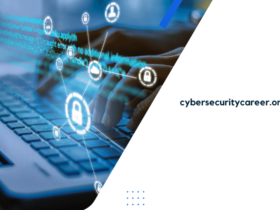Cyber security refers to the practice of safeguarding an organization’s computer systems, devices, and data against threats in cyberspace. This practice encompasses disaster recovery planning as well as preventative methods like employee education.
Attackers are always finding new and inventive ways to penetrate computer and network systems, necessitating constant updates and adjustments to cybersecurity measures in order to remain ahead of attackers.
Definition
Cyber security refers to the practice of safeguarding computer systems, networks and data from unwanted users, attacks or intrusions. It plays an integral part of any business and utilizes various techniques in order to secure its data.
Cyber security definitions vary based on industry and region, but generally include Network, Application, Endpoint and Data security aspects. Network refers to the infrastructure connecting computers together while App refers to software running on these machines.
*Network security refers to methods employed by businesses for protecting their networks from attack by employing methods like firewalls and anti-virus software to ward off outside threats that could come into the network from outside sources. These measures aim to thwart such attacks from occurring.
Applications and cloud computing both demand robust security to protect data in transit between devices or during storage, such as encryption and strong password policies to keep sensitive information safe.
An SQL injection attack enables cybercriminals to access and steal data by inserting malicious code directly into a database via SQL statements, using this form of attack as a backdoor into databases and accessing sensitive data that belongs to both businesses and individuals. It has become one of the primary means of data theft.
Internet threats pose a particular danger when they target unsecured networks and can result in massive data breaches that compromise business data while also leading to reputational and financial damages.
That is why it’s essential to protect and avoid data loss in the first place. To do this, encryption algorithms should be implemented for sensitive information; as well as regularly backing up your data so it can be restored in case of an attack.
Create a business continuity plan to protect operations in the event of a security breach, including having a business continuity and incident response team in place to deal with incidents as soon as they arise, as well as training your employees on how to recognize risks and respond appropriately. This will help prevent data breaches as well as minimise fines and penalties associated with them.
Threats
Cyber security is the study of protecting sensitive information, computer systems and networks from unwarranted access or exposure. Cyber security plays an integral role in keeping digital world safe and secure.
Cyber security faces numerous threats, but among the most prevalent are malware, viruses, phishing attempts and ransomware attacks. These threats have the ability to damage computers or networks and potentially cause severe harm to a business.
Malware is software designed to penetrate devices or networks and steal information, infiltrating via email, website links or downloads. Malware can access confidential data or even take control of a device or network itself.
Spyware is a form of malware that remains undetected on a device and sends data back to a remote location for collection, with monitoring user activities or providing financial data theft being possible as a result. It may be used for spying purposes and/or financial theft.
Viruses are a type of malicious software that infiltrate computers with code that can spread to other devices and compromise the integrity of systems, potentially causing irreparable harm and becoming hard to eradicate. They are highly destructive and often hard to eliminate from systems.
Criminal organizations and nation-states pose cybersecurity threats by infiltrating systems for financial gain through various means such as phishing, spyware, spam and malware attacks to conduct theft, fraud or extortions schemes.
cyber security companies face another threat in the form of malicious actors looking to exploit vulnerabilities in software before its maintainers patch them – this trend, known as zero-day exploits, has become an increasing source of concern over time.
These types of attacks are usually executed by novice hackers known as “script kiddies” who rely on ready-to-use hacking tools, though more sophisticated attackers may also develop their own methods and avoid detection. More likely than others, such attacks would target critical infrastructures and classified networks, leading to significant long-term damage for their targets.
Detection
Cyber security refers to the practice of detecting, identifying, and preventing malicious cyber-attacks against companies. This protects them against damage, disruption, or data loss as a result.
Detection phase of cyber security involves recognizing and analyzing network-wide cyber threats to enable IT administrators to take preventative actions against these threats, such as creating a technical strategy containing various prevention techniques and policies.
Malware detection, ransomware protection and other cyber attacks are essential in safeguarding networks and business operations, while also providing IT teams with an opportunity to quickly respond and mitigate attacks quickly and efficiently.
Threat detection and response tools such as security information and event management (SIEM), network traffic analysis (NTA), and endpoint detection and response (EDR), can help detect threats in your IT environment; however, their ability to analyze all events into one coherent story may be limited.
Traditional SIEMs collect security-data from across your IT environment and generate reports and alerts, but are unable to detect or react to persistent threats that move between silos.
NDR solutions such as SolarWinds’ Security Event Manager (SEM) automate and integrate log data from across your network into one central location, making it easier for administrators to compare this log data against various threat database feeds for faster incident analysis. They provide an overview of events and logs across devices in your network to better prioritize investigations efforts.
Organizations can also utilize behavioral analytics to monitor attacker activity on their network over time. This approach uses small yet seemingly unrelated activities as indicators that an attacker could be up to something in your network.
Threat intelligence can also be obtained by consulting MITRE’s Adversarial Tactics, Techniques, and Common Knowledge (ATT&CK) framework, which works closely with government to protect both citizens and businesses against cybersecurity threats.
Advanced persistent threats (APTs) are targeted attacks designed to infiltrate networks and remain there over an extended period. APTs may be launched by hackers or nation-states wishing to steal sensitive information or conduct espionage, typically employing malware-laced servers and IT systems that collect credentials or gather victim information before exfiltrating that data without detection.
Prevention
Cyber security refers to the practice of detecting, preventing and responding to cyber attacks aimed at individuals, organizations or communities. Cyber security must protect individuals, organizations and communities against being victimized by such attacks.
Businesses are especially susceptible to cyber attacks as they store, process and transmit vast quantities of sensitive data – from financial, personal and health records to intellectual property assets.
Businesses looking to protect themselves from cyber attacks must take certain precautions: Backup their data frequently using various types of backup solutions and encrypt it prior to placing it online.
Companies should make sure their employees understand cybersecurity principles and strategies to combat various attacks, including never clicking links from untrustworthy sources or downloading files from unknown sources, and working only with certified IT specialists.
Employees should participate in IT security courses and follow best practices, to prevent unauthorised access to databases containing sensitive data belonging to businesses.
One way companies can minimize cyber incidents is to limit access to company devices, especially computers and laptops. By restricting physical access and disposing of them appropriately, companies can lower the risk of cyber incidents affecting their operations.
Prior to disposal, all devices should be thoroughly wiped clean and reset – unwiped devices can become vulnerable targets of cyber criminals who use them to gain access to vital business data.
Malware (malicious software) is one of the primary cyber threats, created to cause damage to computers through viruses, ransomware and spyware programs.
Businesses looking to prevent malware should install anti-malware software and protect it with firewalls and other measures to stop any from entering a computer and detect any potentially harmful activity that could potentially be detrimental. Doing so can prevent infection of sensitive information and identify any possible malicious activities before they cause serious issues.
Your best bet for keeping your business safe from cyber threats is hiring an experienced cyber adviser who understands your business. An adviser should be available 24 hours a day, responding to any security needs as they arise, and working closely with you on creating an incident response strategy and response plan in case of an attack or incident.










Leave a Reply